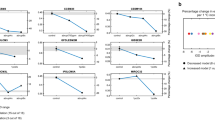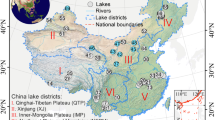Abstract
Phytoplankton form the foundation of the marine food web and regulate key biogeochemical processes. These organisms face multiple environmental changes1, including the decline in ocean pH (ocean acidification) caused by rising atmospheric (ref. 2). A meta-analysis of published experimental data assessing growth rates of different phytoplankton taxa under both ambient and elevated conditions revealed a significant range of responses. This effect of ocean acidification was incorporated into a global marine ecosystem model to explore how marine phytoplankton communities might be impacted over the course of a hypothetical twenty-first century. Results emphasized that the differing responses to elevated caused sufficient changes in competitive fitness between phytoplankton types to significantly alter community structure. At the level of ecological function of the phytoplankton community, acidification had a greater impact than warming or reduced nutrient supply. The model suggested that longer timescales of competition- and transport-mediated adjustments are essential for predicting changes to phytoplankton community structure.
This is a preview of subscription content, access via your institution
Access options
Subscribe to this journal
Receive 12 print issues and online access
$209.00 per year
only $17.42 per issue
Buy this article
- Purchase on Springer Link
- Instant access to full article PDF
Prices may be subject to local taxes which are calculated during checkout




Similar content being viewed by others
References
Gruber, N. Warming up, turning sour, losing breath: Ocean biogeochemistry under global change. Phil. Trans. R. Soc. A 369, 1980–1996 (2011).
Doney, S. C., Fabry, V. J., Feely, R. A. & Kleypas, J. A. Ocean acidification: The other CO2 problem. Annu. Rev. Mar. Sci. 1, 169–192 (2009).
Boyd, P. W. Framing biological responses to a changing ocean. Nature Clim. Change 3, 530–533 (2013).
Bopp, L. et al. Multiple stressors of ocean ecosystems in the 21st century: Projections with CMIP5 models. Biogeosciences 10, 6225–6245 (2013).
Dutkiewicz, S., Scott, J. R. & Follows, M. J. Winners and losers: Ecological and biogeochemical changes in a warming ocean. Glob. Biogeochem. Cycles 27, 463–477 (2013).
Taucher, J. & Oschlies, A. Can we predict the direction of marine primary production change under global warming? Geophys. Res. Lett. 38, LO2603 (2011).
IPCC Climate Change 2013: The Physical Science Basis (eds Stoker, T. F. et al.) (Cambridge Univ. Press, 2013).
Hutchins, D. A., Fu, F.-X., Webb, E. A., Walworth, N. & Tagliabue, A. Taxon-specific response of marine nitrogen fixers to elevated carbon dioxide concentrations. Nature Geosci. 6, 790–795 (2013).
Langer, G., Nehrke, G., Probert, I., Ly, J. & Ziveri, P. Strain-specific responses of Emiliania huxleyi to changing seawater carbonate chemistry. Biogeosciences 6, 2637–2646 (2009).
Fu, F. X., Warner, M. E., Zhang, Y. H., Feng, Y. Y. & Hutchins, D. A. Effects of increased temperature and CO2 on photosynthesis, growth, and elemental ratios in marine Synechococcus and Prochlorococcus (Cyanobacteria). J. Phycol. 43, 485–496 (2007).
Lohbeck, K. T. et al. Adaptive evolution of a key phytoplankton species to ocean acidification. Nature Geosci. 5, 346–351 (2012).
Tatters, A. O. et al. Short- and long-term conditioning of a temperate marine diatom community to acidification and warming. Phil. Trans. R. Soc. B 368, 20120437 (2013).
Crawfurd, K. J., Raven, J. A., Wheeler, G. L., Baxter, E. J. & Joint, I. The response of Thalassiosira pseudonana to long-term exposure to increased CO2 and decreased pH. PLoS ONE 6, e26695 (2011).
Tatters, A. O. et al. Short- versus long-term responses to changing CO2 in a coastal dinoflagellate bloom: Implications for interspecific competitive interactions and community structure. Evolution 67, 1879–1891 (2013).
Lomas, M. W. et al. Effect of ocean acidification on cyanobacteria in the subtropical North Atlantic. Aquat. Microb. Ecol. 66, 211–222 (2012).
Sokolov, A. et al. Probabilistic forecast for 21st century climate based on uncertainties in emissions (without policy) and climate parameters. J. Clim. 22, 5175–5204 (2009).
Boyd, P. W. et al. Marine phytoplankton temperature versus growth responses from polar to tropical waters—outcome of a scientific community-wide study. PLoS ONE 8, e63091 (2013).
Thomas, M. K., Kremer, C. T., Klausmeier, C. A. & Litchman, E. A global pattern of thermal adaptation in marine phytoplankton. Science 338, 1085–1088 (2012).
Eppley, R. W. Temperature and phytoplankton growth in the sea. Fishery Bull. 70, 1063–1085 (1972).
Hofmann, G. E., Smith, J. E. & Johnson, K. S. High-frequency dynamics of ocean pH: A multi ecosystem comparison. PLoS ONE 6, e28983 (2011).
Dornelas, M. et al. Assemblage time series reveal biodiversity change but not systematic loss. Science 344, 296–299 (2014).
Bopp, L., Aumont, O., Cadule, P., Alvain, S. & Gehlen, M. Response of diatoms distribution to global warming and potential implications: A global model study. Geophys. Res. Lett. 32, L19606 (2005).
Feng, Y. et al. Effects of increasing p CO 2 and temperature on the North Atlantic spring bloom. I. The phytoplankton community and biogeochemical response. Mar. Ecol. Prog. Ser. 288, 13–25 (2009).
Kim, J.-M. et al. The effect of seawater CO2 concentration on growth of a natural phytoplankton assemblage in a controlled mesocosm experiment. Limnol. Oceanogr. 51, 1629–1636 (2006).
Brussaard, C. P. D. et al. Arctic microbial community dynamics influenced by elevated CO2 levels. Biogeosciences 10, 719–731 (2013).
Tortell, P. D., DiTullio, G. R., Sigman, D. M. & Morel, F. M. M. CO2 effects on taxonomic composition and nutrient utilization in an Equatorial Pacific phytoplankton assemblage. Mar. Ecol. Prog. Ser. 236, 37–43 (2002).
Hare, C. E. et al. Consequences of increased temperature and CO2 for phytoplankton community structure in the Bering Sea. Mar. Ecol. Prog. Ser. 352, 9–16 (2007).
Poloczanska, E. S. et al. Global imprint of climate change on marine life. Nature Clim. Change 3, 919–925 (2013).
Schaum, E., Rost, B., Millar, A. J. & Collins, S. Variation in plastic responses of a globally distributed picoplankton species to ocean acidification. Nature Clim. Change 3, 298–302 (2013).
Boyd, P. W., Lennartz, S. T., Glover, D. M. & Doney, S. C. Biological ramifications of climate-change-mediated oceanic multi-stressors. Nature Clim. Change 5, 71–79 (2015).
Marshall, J., Adcroft, A., Hill, C. N., Perelman, L. & Heisey, C. A finite-volume, incompressible Navier–Stokes model for studies of the ocean on parallel computers. J. Geophys. Res. 102, 5753–5766 (1997).
Large, W. G., McWilliams, J. C. & Doney, S. C. Oceanic vertical mixing: A review and a model with a nonlocal boundary layer parameterization. Rev. Geophys. 32, 363–403 (1994).
Gent, P. R. & McWilliams, J. C. Isopycnal mixing in ocean circulation models. J. Phys. Oceanogr. 20, 150–155 (1990).
Sokolov, A. & Stone, P. H. A flexible climate model for use in integrated assessments. Clim. Dynam. 14, 291–303 (1998).
Schlosser, C. A., Kicklighter, D. & Sokolov, A. A Global Land System Framework for Integrated Climate-Change Assessments Report No. 147 (MIT Joint Program for the Science and Policy of Global Change, 2007); http://web.mit.edu/globalchange/www/MITJPSPGC_Rpt147.pdf
Bonan, G. B. et al. The land surface climatology of the Community Land Model coupled to the NCAR Community Climate Model. J. Clim. 15, 3123–3149 (2002).
Felzer, B. et al. Effects of ozone on net primary production and carbon sequestration in the conterminous United States using a biogeochemistry model. Tellus B 56, 230–248 (2004).
Liu, Y. Modeling the Emissions of Nitrous Oxide (N 2 O) and Methane (CH 4 ) from the Terrestrial Biosphere to the Atmosphere Report No. 10 (MIT Joint Program on the Science and Policy of Global Change, 1996); http://globalchange.mit.edu/files/document/MITJPSPGC_Report10.pdf
Kalnay, E. et al. The NCEP/NCAR 40-year reanalysis project. Bull. Amer. Meteorol. Soc. 77, 437–470 (1996).
Randall, D. A. et al. in Climate Change 2007: The Physical Science Basis (eds Solomon, S. et al.) Ch. 8 (IPCC, Cambridge Univ. Press, 2007).
Yin, J. A consistent poleward shift of the storm tracks in simulations of 21st century climate. Geophys. Res. Lett. 32, L18701 (2005).
Fyfe, J. C. & Saenko, O. A. Simulated changes in the extratropical Southern Hemisphere winds and currents. Geophys. Res. Lett. 33, L06701 (2006).
Parekh, P., Follows, M. J. & Boyle, E. A. Decoupling of iron and phosphate in the global ocean. Glob. Biogeochem. Cycles 19, GB2020 (2005).
Luo, C. et al. Combustion iron distribution and deposition. Glob. Biogeochem. Cycles 22, GB1012 (2008).
Elrod, V. A., Berelson, W. M., Coale, K. H. & Johnson, K. S. The flux of iron from continental shelf sediments: A missing source for global budgets. Geophys. Res. Lett. 31, L12307 (2004).
Follows, M. J., Dutkiewicz, S., Grant, S. & Chisholm, S. W. Emergent biogeography of microbial communities in a model ocean. Science 315, 1843–1846 (2007).
Dutkiewicz, S., Follows, M. J. & Bragg, J. Modeling the coupling of ocean ecology and biogeochemistry. Glob. Biogeochem. Cycles 23, GB1012 (2009).
Kooijman, S. A. L. M. Dynamic Energy and Mass Budget in Biological Systems (Cambridge Univ. Press, 2000).
Bissinger, J. E., Montagnes, D. J. S., Sharples, J. & Atkinson, D. Predicting marine phytoplankton maximum growth rates from temperature: Improving on the Eppley curve using quantile regression. Limnol. Oceanogr. 53, 487–493 (2008).
Acknowledgements
We acknowledge funding from NSF grant OCE-1315201 (J.J.M., S.D., M.J.F., S.T.D.), DOE grant DE-FG02-94ER61937 (S.D., J.S.), the Gordon and Betty Moore foundation (S.D., M.J.F.), NSF grant OCE 13-14336 (S.T.D.), German–Israel Joint Research BMBF-MOST grant GR1950 (I.B.-F.), the BEACON Center for the Study of Evolution in Action NSF grant DBI-0939454 (J.J.M.) and a NASA Astrobiology Institute Postdoctoral Fellowship (J.J.M.).
Author information
Authors and Affiliations
Contributions
S.D., M.J.F., J.J.M. and I.B.-F. conceived the experimental design, J.J.M. conducted the literature meta-analysis, J.S. provided the fields from the earth system model, S.D. conducted the numerical experiments and analysed the results. O.L., I.B.-F. and S.T.D. provided contextual input. S.D. and J.J.M. co-wrote the paper, with input from all authors, especially I.B.-F. and S.T.D.
Corresponding author
Ethics declarations
Competing interests
The authors declare no competing financial interests.
Supplementary information
Rights and permissions
About this article
Cite this article
Dutkiewicz, S., Morris, J., Follows, M. et al. Impact of ocean acidification on the structure of future phytoplankton communities. Nature Clim Change 5, 1002–1006 (2015). https://doi.org/10.1038/nclimate2722
Received:
Accepted:
Published:
Issue Date:
DOI: https://doi.org/10.1038/nclimate2722
This article is cited by
-
Carbon sequestration by multiple biological pump pathways in a coastal upwelling biome
Nature Communications (2023)
-
Short-term acidification promotes diverse iron acquisition and conservation mechanisms in upwelling-associated phytoplankton
Nature Communications (2023)
-
Recent trends in the chemistry of major northern rivers signal widespread Arctic change
Nature Geoscience (2023)
-
Community context and pCO2 impact the transcriptome of the “helper” bacterium Alteromonas in co-culture with picocyanobacteria
ISME Communications (2022)
-
Enhanced silica export in a future ocean triggers global diatom decline
Nature (2022)



